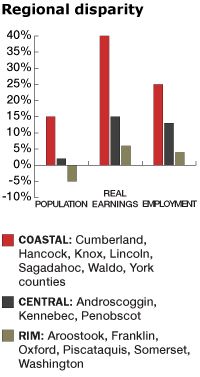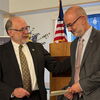Setting the stage | Maine's biggest industries face enormous challenges. What are they, and more importantly, how will they meet them?
This is the first installment of a six-part series by economists Michael LeVert and Chuck Lawton that will explore what Maine's business decision makers really need to make a go of it. An Editor's Note follows the article.
Discussions about Maine’s future prosperity inevitably center on business. How do we attract more businesses? How do we keep the ones we have? How do we stay competitive, support clusters, develop new markets?
There is no shortage of strategies to address these questions — wind power, tax reform, Pine Tree Zones, quality of place, medical schools, carbon offsets, eco-clusters, to name a few. All are designed, in one way or another, to answer the larger question: How do we bring sustainable economic growth and prosperity to Maine people?
Over the next several months, we’re going to ask decision makers within four key Maine industries — paper making, health care, tourism and energy — that very question. We’ll look at the statistical trends and talk to business owners. We’ll focus on what strategies they’re pursuing to address these fundamental facts of economic life. We’ll learn how they see Maine’s economic future.
What are they facing in this economic climate? Plenty. Over the past two decades, Maine’s economy has seen four fundamental changes—a structural upheaval in the sources of our employment, significantly slower rates of growth, an aging population and labor force, and increasing regional disparities. Any discussion of economic development strategy that does not address these fundamental facts is incomplete.
Where the jobs will be
The story of employment over the past 20 years has been one of steady job losses in goods-producing industries — textiles, shoes, apparel and, more recently, pulp and paper — and steady job growth in service-providing industries, primarily health care and, to a lesser extent, tourism.
Slower growth
These changes in the type of employment have been accompanied by markedly slower rates of growth. Over the past two decades, Maine’s total job growth has been barely half the national average, and Maine’s population growth has been barely one-third the national average. Earned income also grew substantially less than the national average.
We’re all getting older
At least in part because of this slow employment growth, Maine has gotten significantly older. In 1990, the share of Maine’s population under age 25 was 35%, and the share over age 55 was 22%. Today, those shares have converged to 29% each.
This pattern of aging is expected to continue. In 2020, more than 1 in 5 Mainers will be older than 65.
It begs the question: Where will the workers come from to staff Maine’s businesses tomorrow?
The difference of where you live and work
Since the job losses in manufacturing have come disproportionately from Maine’s rural counties, one significant effect of the trends noted above has been a dramatic increase in regional disparity. Since 1990, population in Maine’s rim counties has declined by 5%, compared to increases of 15% and 2% in coastal and central counties, respectively. Over the past two decades, real earnings growth has grown seven times faster in coastal counties than in rim counties and two a half times faster in central counties.
These underlying trends — change in the types of employment, slow growth, an aging population and growing regional disparity — form Maine’s business environment, representing challenges and opportunities.
In this series, we’ll look at several Maine industries and see how they’re responding to these challenges. Here’s a peek:
Paper Manufacturing: In 1997, 14,000 people worked in the paper industry, accounting for 4.4% of Maine’s GDP. Ten years later, in 2007 (the most recent year available), employment and contributions to real GDP have both fallen by 40%. Since paper industry jobs have been a mainstay in rural communities for generations, these changes have understandably been unsettling. Lowering production costs, through transportation improvements and cheaper electricity for example, will be important to stabilizing these trends. But, at least for the foreseeable future, power, labor and environmental costs will always be lower in some other parts of the globe. Maine’s advantage lies with its proximity to millions of acres of sustainably managed (and certifiable) fiber and an experienced, skilled and hard-working labor force. Finding ways to add value to this resource — for example, by certifying products as sustainably managed or by cornering niche or emerging markets — will be key to long-term success. So will finding and training a new generation of skilled employees to replace an aging work force.
Health Care: Maine’s fastest-growing sector has been and will continue to be health care. Jobs in health care have increased by 25,000 since 1997, now employing 16% of Maine people. Health care’s contribution to Maine’s GDP has increased by a third, from 8.4% in 1997 to 11.2% today. An aging population will exert two competing forces on the health care industry. On one hand, demand for medical services from older Mainers can be counted on to fuel significant job and output growth, particularly accompanied by new technology and advanced medical procedures. At the same time, finding and training health care workers, particularly as many experienced workers retire, will be a challenge. Rural communities are becoming increasingly dependent on health care jobs — a quarter of the jobs in Aroostook and Washington counties are in health care — which in turn is increasingly dependent on state and federal Medicare dollars.
Tourism: Employment in leisure and hospitality businesses has increased 15% since 1997, employing one in 10 Mainers in 2008, and accounting for 4% of Maine’s GDP. So far, most of these jobs have been concentrated in southern and coastal areas. Meeting the challenges of moving tourists inland and becoming a year-round world class destination will require entrepreneurial spirit, infrastructure improvements and work force development.
Energy: Ten years ago, plans to use wind, tidal, solar and biomass to create heat and energy were in their infancy. Today we have more than 10 onshore wind farms in operation or in the planning stages. Locations for pilot offshore wind and tidal power projects will be finalized by the end of the year. Four pellet plants are operating and another is in the advanced planning stage. Many business and policy leaders are counting on the energy sector to drive job growth in Maine for years to come.
Over the next few months, we’ll examine in more detail the trends, challenges and opportunities facing these four important Maine industries and pay particular attention to what public policies are most crucial to their success.
No economic or business development strategy occurs in a vacuum. It plays out in the context of underlying changes in the economic landscape. Understanding these changes and recognizing the challenges they pose are critical to successful public-private collaboration in support of economic growth.
Michael LeVert and Chuck Lawton can be reached at editorial@mainebiz.biz.
Read Part II: Paper goods
Read Part III: Rx for growth














Comments